#i did so much research about heian fashion
Explore tagged Tumblr posts
Text
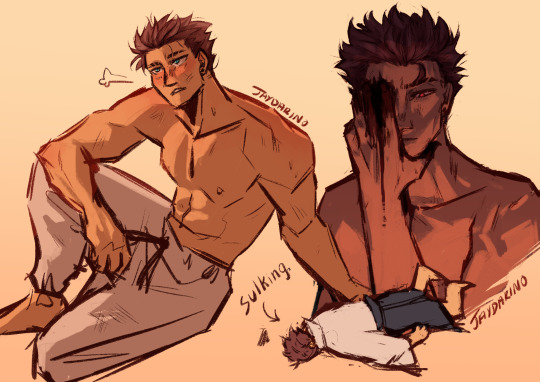

Human sukuna sketches
Close ups:
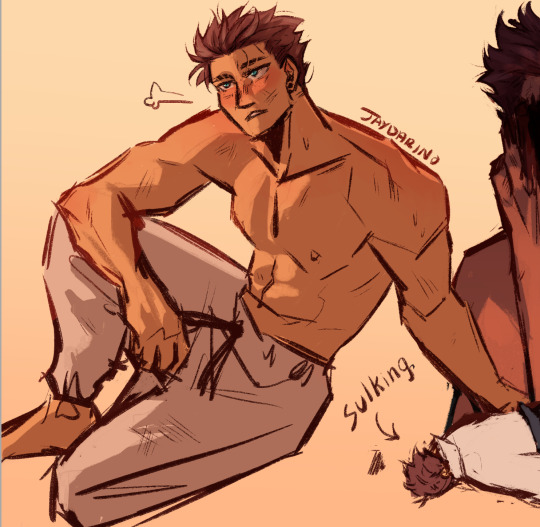
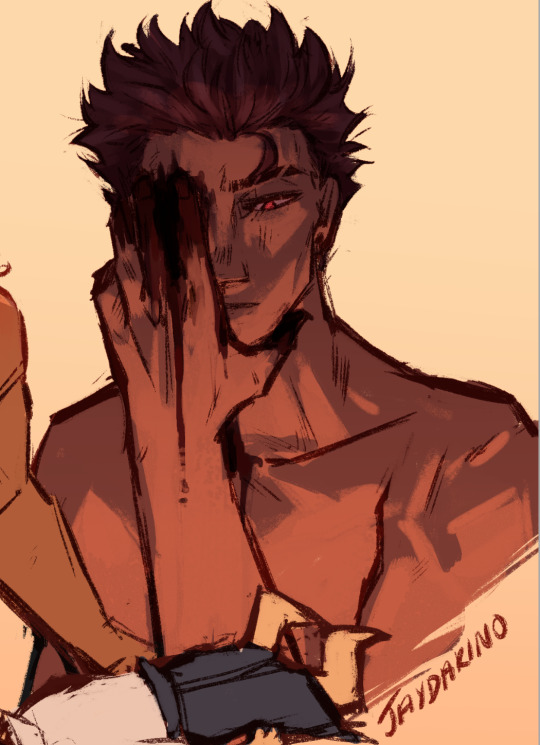

#my head is rotted over his backstory#gege please. its a base need..#i did so much research about heian fashion#only to draw him shirtless 90% of the time#who needs historical accuracy when you have hot man#ryomen sukuna#jjk#jujutsu kaisen#jjk fanart#true form sukuna#heian era sukuna#i neglected to do college work for this
2K notes
·
View notes
Text
Kimetsu no Yaiba and its ties with traditional Japanese culture
Just a ramble and a little dive into what makes the Kimetsu fandom so engaging for someone who, as I like to say, “broke the weeb scale a long time ago.”
From the perspective of the craft of writing, Gotouge is clearly a novice. While Kimetsu is not a debut work, it’s nearly that, which is why Gotouge only got so big of a deal on anime rights due to (previous) lack of name recognition. It commits all kinds of writing sins; the flashbacks were never hinted to until they become relevant, contrived conveniences move the plot, and I’ve never seen more egregious use of telling instead of showing. But despite all that, it’s told with a lot of heart. The core bonds between people and character motivations drive the story beyond all those execution flaws. The premise is straightforward and hits on core classic themes found throughout human history of fiction. It’s that lack of nuance sometimes, as well as the pure love put into these characters, that sometimes makes me feel like I’m watching a little alligator child play with action figures and light up as they pause the pretend dialogue to tell you all kinds of exciting things about the world they are having the toys fly through whilst also making ‘bang, pow’ sound effects as they resume play. (The art likewise commits so many sins but that is so freaking endearing, let’s move on.) A large part of what attracted me to Kimetsu in the first place was the aesthetic. Samurai style warfare never gets old, element-based powers never get old, and when it comes to character designs, the motifs used throughout the series are merchandise gold for how recognizable they are. There’s a certain lack of mainstream Taisho Era manga, despite that being a very exciting and fashionable era made all the more nostalgic for its brevity and relative pre-Showa peacefulness. You know what, I’m just going to skip the preamble and get straight to it: the more deep diving you do, the more you realize, oh hell, this alligator had a ship-ton of detail and background in this.
Whether intentional or not, the series has provided a huge wealth of ties to traditional folklore, and when people who know a lot about this stuff start theorizing and pulling in outside research, dang, they can get going. Some examples I’ve heard: 1. Drawing comparisons to just about every demon legend out there, including spider demons in the mountain, demons that mingle among the courtesans, demons that attain the ability to live among humans by practicing self-restraint, and so on and so on and so on. 2. Tracing the origins of the series to some of the most ancients writings in Japan and showing how many rules and themes of demon slaying have remained consistent throughout centuries of legends. 3. Diving into the local folklore of the places tied with the series (for example, I heard a passing comment about the islands were Iguro is from having men and women live separately, which I have not verified with my own research). 4. Pulling in places not mentioned specifically in canon but bare distinct similarities with canon elements, such as many tourist sites that have recently exploded in popularity around the country (for example, one of my favorite sword-forging sites in Shimane, or a couple shrines that just happen to be called Kamado Shrine with the same somewhat rare kanji, or a garden famous for its extensive use of wisteria.) 5. Diving into the origins of names (such as how the pronunciation of “Agatsuma” has roots in Shinto mythology of a god singing the praises of his wonderful wife) and traditional patterns (the Ichimatsu (checkerboard) patterns having ties to enduring continuity, many other patterns being used to ward off evil, etc.) It’s such a fun rabbit hole (or, swamp demon hole??) which fans go really, really deep in their theories, bringing in uncanny comparisons to historical botanists or insisting that just because something has roots in the Heian period it must be chosen on purpose because you know who else has roots in the Heian period? Kibutsuji Muzan. It’s all connected, Wani-sensei, sugooooooiiiiiiii!!!! And I love to get wrapped up in that too (see here), but then when I consider translating the juicy details, I usually stop for two reasons:
1. That’s... that a lot of background that would take a really long time to explain. 2. When you get down to it, a lot of it is just fun coincidences, and I think it’s too far of a stretch to make them canon theories. It’s when I choose not to translate them that I reach two conclusions. 1. Whether consciously or unconsciously, it’s very possible Gotouge did take these sorts of very, very trivial details into account when designing the characters, especially giving the very clear level of research that did go into specifying a lot of the character details. Like, seriously, Wani-sensei, how many yyyyyyyears have you spent soaking all this up? The sheer level of Taisho Era world building is a testament to that. 2. Even without all those layers of ties to centuries and centuries of folklore, at its core, the story remains engaging because of the elements mentioned previously. It’s a classic tale of good versus evil; there are no elemental powers, it’s just people doing the best they can because they have motives that drive them--familial love, revenge, duty, regret, filling in something that’s missing. But oh, man, oh my demons, how I love, love, love how this series stokes my nerdy side, I love it, I want to climb ALL THOSE MOUNTAINS AROUND TOKYO AS FANDOM PILGRIMAGES AND DON’T EVEN GET ME STARTED ON HOW MUCH THIS FANDOM HAS INFILTRATED EVEN MY TEA CEREMONY LESSONS EVER SINCE THAT RIKYU-BAI NATSUME REMINDED ME AND MY CLASSMATE OF UZUI TENGEN, I CANNOT FULLY CONCENTRATE or even BREATHE, SENSEI, I CANNOT PRACTICE THIS ‘OCHA NO KOKYUU’ WHEN YOU KEEP MAKING KIMETSU REFERENCES, AND I AM NOT EVEN THE ONLY ONE WHO MADE THAT INOKO-MOCHI JOKE, STAHP------
130 notes
·
View notes
Note
so Kagura dresses like a dancer and Hakudoshi wears his 'suikan' like a noble. but i've never heard anything about what Kanna wears. the inuyasha wiki claims that both she and Shunran wear kimono but I'd like to know more if that's possible. sorry if you've already answered something like this before, but I can't even figure out how to work some of the websites in the research guide...
Thank you for actually checking out our Research Guide before asking (a lot of people don’t think to)! Sorry to hear you couldn’t find the answer that way on your own; let’s see what we can do to help...First, let’s get this out of the way: it’s technically never inaccurate to refer to traditional Japanese-type clothing like Kanna’s as “kimono” since it’s still a term used for it today. However, that’s very general - literally, the word originally meant just “thing to wear” (mono was “thing”, ki is one way of saying “wear”)...so in other words, my hand to god, at the time the story is set, it just meant “clothing”. Congratulations Kanna, you are wearing clothing! :DAh...not helpful? No, not helpful.All kidding aside, it’s true that the term as it’s used today is a little more specific, but it’s not by much: these days, even in post-Meiji era Japan, "kimono” refers to specifically “ethnically Japanese” i.e. traditional Japanese clothing (the more general term in the modern era for “clothing” in Japanese is apparently 被服, which we would romanize as hifuku)... but, that is still unhelpful because yes, we can see it’s “Japanese” clothing, but seeing as “Japanese clothing” refers to a REALLY broad swath of clothing ranging from furisode to yukata, suikan etc - it’s incredibly non-specific. In other words, almost as bad as calling both pants and skirts “hakama”; accurate, but not helpful in the least! :PSo. What IS she wearing?Well, I...am sorry to break it to you but I’m not entirely sure yet, anon. >_>Since I’m prepping for Hurricane Irma as I respond to this, I’m unfortunately unable to do that much poking around, but I will say I immediately noticed something interesting about it after looking up reference pictures, one of which was this screencap from the anime adaptation (which is I believe from "Kagura's Dance and Kanna's Mirror", from Season 2, in which Kanna first appears):
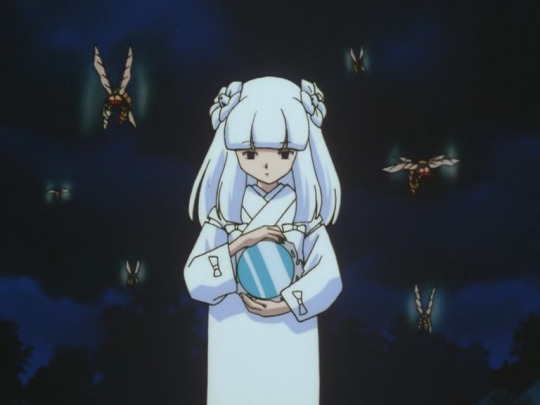
Actually, let’s summarize what I’m noticing here, which helps me tell you what it is definitely NOT, and hypothetically might be (or...I thought it might be, more on that in a moment):1.) Looking at the ends of the sleeves near the wrist I can tell her garment is NOT any kind of furisode (literally “swinging sleeve”) type kimono, which have long sleeves that hang down (Sesshomaru’s top, for comparison, is a furisode).2.) Her sleeves are more like those found on the kimono type called a kosode (literally “small sleeves”). They are meant to not get in the way, in other words (Sango wears a kosode when she’s not just wearing her armor by itself, for another comparison; you can see the end of the sleeve near the wrist is of similar design).
3.) SLITS IN THE SHOULDERS.I’m going to have to add some visual ref here to point out why this jumped out at me as a detail.This is a “standard” looking kosode:
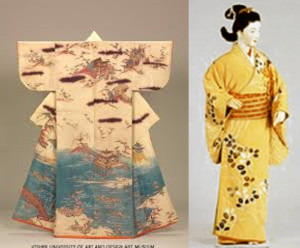
(image pulled from this nifty overview of the evolution of kimono! I recommend giving it a read, it’s very informative!)Now. Pay attention to the shoulders. Scroll back up, and compare - again, there are slits in Kanna’s kimono’s shoulders, but not in “standard” kosode designs.
Slits in that position on the shoulders aren’t at all unheard of in traditional Japanese clothing - they’re found in the suikan type garment that Inuyasha and Hakudoshi both wear, for instance, which as we’ve mentioned before, is designed for as a “hunting jacket” type garment, making me think that that’s why this garment of hers also has them? - but it’s not always a standard feature.(It’s also a feature in Kikyo’s outfit by the way:
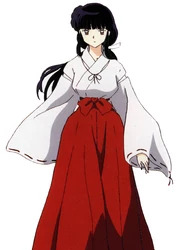
Kikyo is an archer, so it makes sense she’d enjoy the fuller movement that those slits provide! Why does Kanna need it though if she relies on her soul-sucking mirror as her “weapon”? Hm. Good question!)Oh -and one more thing. Which I almost missed but which kicks it out of just “kosode” into “okay no, this is a fair freaking question, what IS this??”Look at this other screenshot from the anime I ran across when trying to see “what her obi looked like”:
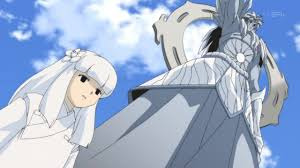
What in the....there’s. Wait. No. That - can’t be.....?*googles more screenshots, confirms*
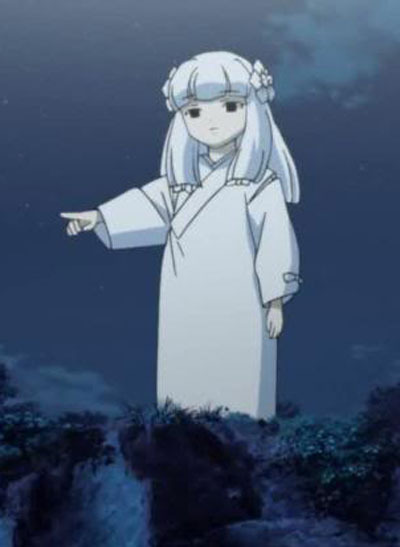
THERE’S NO OBI.NONE. AT ALL. WHATThere’s no belt?? Where’s the ties?? Is this even a real old-school kimono style or at this point is Takahashi kind of just making it up because “hey it’s a youkai anyway so whatever”? Is it tucked up in there?? How is this even staying in place...? (There’s also those little bows to consider, granted - but I feel like most of those are probably decorative? - but it’s hard to tell, without knowing what the garment even is! Maybe they’re not! Schrodinger’s bows)Okay, Anon. Yes. I see now why you sent this in. I SEE it. I never looked closely at her outfit before and now that I have, I am so far baffled. o_O All in all, I’m not sure exactly what is up with Kanna’s outfit - not 100%. But I do find it interesting (and probably notable!) that it has slits in sleeves, and that it’s clearly not held in place with a normal old-fashioned obi, as we think of one at least. It’s possible (just spit-balling here, especially with Hakudoshi “wearing his suikan like a noble”, and Naraku’s having taken over a noblemen’s place!) that it’s a REALLY old-fashioned noble class children’s outfit? Maybe? That might be a good avenue for research (and I probably would have tried it, were I not prepping for a major hurricane this weekend, sorry anon! ^^;;). I wouldn’t even be surprised if it would be old-fashioned even by Sengoku era standards, mind - we know Takahashi included a by-then-“old-fashioned” suikan for Inuyasha (and Hakudoshi) and put Inuyasha’s very much human mother in a junihitoe (the latter is more like from the Heian period, MUCH earlier), so you never know. Keep it in mind!I will say this though:The more I think about it, the more I find it extremely interesting, too, that the ENTIRE outfit - outer garment, undergarment (which she does have; you can see it under her collar, peeking out through the sleeve-slits, and if you saw a full-body shot that showed her feet, peaking out from under the bottom of her outer garment as well)... the bows on the outfit... even her very hair, and even the decorations in her hair! - All, ALL of them, are solid, pure, non-patterned white.Why do I find this so striking?Because of the various nuanced implications of that in Japanese culture (warning: this link includes a picture of a Japanese corpse being prepped for burial. It’s actually not gross looking at all, but you may find it spooky or unsettling when you realize what it is, so I feel a need to warn ahead of time).Now, despite what the warning in parentheses for that link might seem to imply, and despite what some rumors may say, “death” isn’t the only association with white (and especially white clothing) in Japanese culture; it’s associated with “purity” and cleanliness as well. People aren’t just buried in white, they’re often married in it, too, and many priests and priestesses in Shinto and Buddhism include white clothing in their garb, especially for specific rituals requiring “purity”.I also will clarify that that is NOT a funerary kimono, in the sense that she’s wearing it folded the normal way, and not the opposite way, which corpses are dressed in, so let’s clear that up right away, that she’s not dressed “like a corpse”. At all. But.Still...This feels like it can’t be coincidental...? It’s hard to tell if the white theme is a sign of her “blankness”/emptiness (which is another fair possibility), or if it’s indeed meant to evoke those other WELL known elements in Japanese spiritual beliefs (and it’s still noteworthy I think that to the Japanese, it IS still common to see ghosts wearing solid white, because they are still buried in white, so there’s the subconscious “creepy factor” too, sure)...hn. It’s a real question!I am starting to doubt that it was purely for aesthetics or to save on ink though :P So basically the short answer is: I am real sorry anon, I have no idea. :( I wish I did!The long answer, clearly, is: “WAIT, THIS RAISES EVEN MORE QUESTIONS...??”-Mod VorpalGirl(PS: I probably will not be online the rest of this weekend, at least on here. Seriously, Irma is making her cranky way right up my home State and we decided not to evacuate sooooo. Not only do we need to prep like heck tomorrow, power will likely go out for us before Monday, and given what happened with Hurricane Matthew last year, that could keep me away from ya’ll for up to a week or so. >_> Wish me luck....and Tekka too, since she’s still likely in the path of it as well)
22 notes
·
View notes
Text
11 Questions!
Tagged by @mysecretfanmoments! <3
Answer 11 questions, then make 11 new questions and tag 11 people!
1. if given an opportunity to be an author of a novel, what era would you choose as the setting for that novel? (yes I stole that question)
If I had all the time for research in the world then Heian Japan ( 794–1185 CE), although writing something during the Genpei War or Bakumatsu could also be very interesting. However, I’d really want to make sure I got all the details right. I’d also possibly be interested in writing something set during either Roman Britain or during the Viking Age. . . .
2. Do you cook? What is your fav dish to make? (Or that you wish you could cook?)
I CAN cook, but I’m often too lazy to put much effort into it unless it’s for a party or holiday dinner. I do really love to bake. I like making blondie bars from my great-grandmother’s recipe. Oh! Also my grandmother and I use to make lefse together and I loved that!
3. Dyed hair, piercings or tattoos?
I have 5 piercings in my ears total. Currently my hair is mostly natural but I have some blue, teal, and burgundy in the under-layer of my hair (so I can hide it for work interviews). I’ve been thinking about getting a tattoo on my sternum, but I hear it hurts like a b****.
4.How often do you read books? And fanfic?
Often. On both accounts.
5. In a classic detective story, who would you be? The detective, the clueless inspector, the crying maid or the victim?
Wait what? I. . . am honestly not sure. Hmmmm. A fly on the wall maybe.
6. Fav sport to watch.
Ice Hockey and Figure Skating! Satoko Miyahara is my fav! I apparently really like ice, and yes I greatly enjoy the winter olympics.
7.Any fashion style you would like to try?
Quite a few, but I’m usually too lazy to do anything consistently. I sometimes lean to “mori-kei” and could possible even keep that up . . . but I wear more dark colors.
8. Fav national holiday.
I don’t think it’s a national holiday, but Halloween! Or maybe the day after Valentines when all the chocolate is half off . . . .
9. If you were an idol singer, what would be your stage name?
Idol? Like. . . an idol pop group? Hmmmm. . . . based off my name on here can I just be “The Empress”? Or can I still Leliana’s “Nightingale”?
10. Drawing or writing?
I’m currently trying to improve my skills at both!
11. What fictional world would you like to visit?
Oh this is hard! There are so many I’d LIKE to visit, but only under certain stipulations . . . because frankly I’d probably get myself killed in many fantasy worlds. In theory I want to see Middle Earth or Thedas, but I also realize I have NO life skills that would be needed in those ‘verses. . . and that I’d most likely die. Maybe . . . . Star Trek? I’m not even a Trekie in particular, but it seems like an interesting one. Though . . .re-reading I see this says “visit”, so assuming it’s a short visit and I can control when I leave: Middle Earth or Thedas.
So here are my 11 questions (and I’m going to cheat a steal a couple of these from the ones I did):
1. What is your favorite quote, or one that you find inspirational?
2. If you were a D&D character, what class would you be?
3. What’s your favorite breakfast food?
4. Do you enjoy listening or playing music (or singing) more?
5. Who are 5 fictional characters you wish you could meet?
6. Who are 5 famous (current or historical) figures you wish you could meet?
7. What’s your favorite food to eat during cold weather?
8. What’s your favorite food to eat during hot weather?
9. Do you prefer phone calls, text messages, or talking in person?
10. Dyed hair, piercings or tattoos?
11. What fictional world would you like to visit?
If you have time to do this and are so inclined: @adventuresinastrangeworld, @wardsarefunctioning, @dragynfox, @thema-sal-shiral, @thranduilsausage, @fadedforyou, @cinisofages, @fargreencountryswiftsunrise, @hellofeanor, @jahaliel, @elfsplaining
4 notes
·
View notes